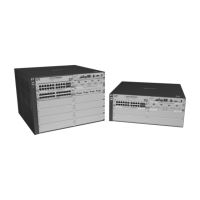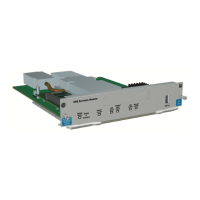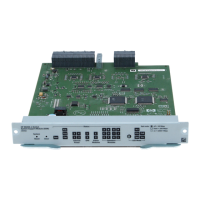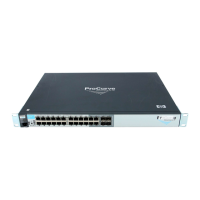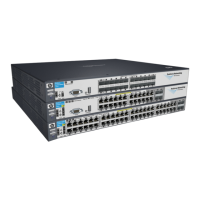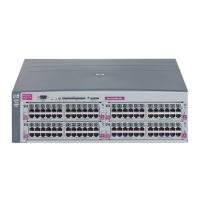
Do you have a question about the HP ProCurve 5300xl Series and is the answer not in the manual?
| Model | HP ProCurve 5300xl Series |
|---|---|
| Layer | Layer 3 |
| Jumbo Frame Support | Yes |
| Subtype | Managed |
| Manageable | Yes |
| Ports | 24 or 48 |
| MAC Address Table Size | 16, 000 entries |
| Routing Protocol | RIP, OSPF, BGP, PIM |
| Remote Management Protocol | SNMP, CLI |
| Features | VLAN, QoS |
| Management | CLI, Web UI |
| Operating Temperature | 0°C to 50°C |
| Power over Ethernet (PoE) | Available on some models |
| Operating Humidity | 15% to 95% non-condensing |
Explains how VLANs form broadcast domains and the operation of port-based VLANs.
Details the operation of the default VLAN and multiple port-based VLANs.
Covers rules for DHCP/Bootp, per-VLAN features, default VLAN, and port assignments.
Outlines steps for planning VLAN strategy and port assignments.
Details the process of configuring port-based and protocol-based VLAN parameters.
Explains the general applications and options of 802.1Q VLAN tagging technology.
Lists restrictions on port membership, tagging, and routing capabilities.
Explains GVRP's advertisement of static VLANs and dynamic joining of advertised VLANs.
Outlines steps for setting up dynamic VLANs for a network segment.
Details how to view, enable, disable, and specify port advertisement handling for GVRP.
Describes using the menu interface to view and configure GVRP.
Describes using the CLI to view and configure GVRP.
Describes using the web browser interface to view and configure GVRP.
Explains IGMP general operation and features for multimedia traffic control.
Guides on using CLI commands to configure and display IGMP settings.
Explains how to enable or disable IGMP using the web browser interface.
Describes the operation of the Internet Group Management Protocol (IGMP).
Details configuring Forced Fast-Leave IGMP on a per-port basis.
Explains PIM-DM operation for directing multicast traffic efficiently.
Provides details on managing forwarding and pruned flows in PIM-DM.
Lists the required elements for PIM-DM configuration.
Lists operating rules for PIM-DM, including flow capacity and MRT.
Details configuration steps at the global and VLAN interface levels.
Explains global configuration parameters for PIM-DM.
Explains VLAN interface configuration parameters for PIM-DM.
Guides on displaying PIM data and configuration settings.
Compares RSTP and STP spanning tree options and their functionalities.
Describes the operation and configuration of the IEEE 802.1w Rapid Spanning Tree Protocol.
Outlines general steps for configuring MSTP operation.
Details configuring MSTP operation mode and global parameters.
Explains configuring basic port connectivity parameters for MSTP instances.
Guides on configuring MST instance parameters and VLAN mapping.
Details configuring MST instance per-port parameters.
Offers guidance on troubleshooting MSTP issues like duplicate packets.
Details classifiers used for prioritizing outbound packets on 5300xl and 3400cl/6400cl switches.
Explains how to use QoS classifiers for outbound traffic priority.
Details assigning 802.1p priority based on TCP or UDP port number.
Explains assigning priority based on IP address (source or destination).
Covers ToS IP-Precedence and Diffserv modes for packet prioritization.
Guides on assigning priority based on VLAN-ID.
Explains assigning priority based on the source-port.
Describes the process of configuring and assigning ACLs to interfaces.
Guides on configuring IP parameters for routing switches.
Details configuring IP addresses on routing switch VLAN interfaces.
Guides on configuring ARP parameters.
Details configuring forwarding parameters like TTL and directed broadcasts.
Covers configuring ICMP limits and disabling messages.
Guides on configuring static IP routes.
Details the process of configuring a static IP route.
Describes how to configure RIP using the CLI interface.
Guides on configuring RIP parameters system-wide and per VLAN.
Details configuring routing switches to redistribute routes into RIP.
Describes how to configure OSPF using the CLI interface.
Outlines steps for beginning OSPF usage on the switch.
Explains how to configure IRDP for advertising router interfaces.
Describes DHCP relay configuration.
Guides on enabling DHCP Relay.
Details configuring helper addresses for VLANs.
Explains UDP broadcast forwarding on 5300xl switches.
Guides on configuring and enabling UDP broadcast forwarding.
Details configuring Static NAT for intranet applications.
Guides on configuring static NAT.
Explains how routing functions transfer when a router in the Protection Domain fails.
Guides on performing XRRP configuration via the switch console CLI.
Covers customizing XRRP configuration using command options.
Details enabling and disabling XRRP on the switch.
Details the process of configuring and bringing up a stack.
Explains how the Commander manages the stack, members, and access.
Details configuring a switch as a Commander.
Explains how to access member switches via the Commander for configuration and monitoring.

